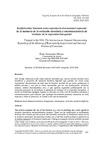Identificador persistente para citar o vincular este elemento:
https://accedacris.ulpgc.es/handle/10553/52988
| Campo DC | Valor | idioma |
|---|---|---|
| dc.contributor.author | Fernández Macías, Érika | en_US |
| dc.date.accessioned | 2019-02-04T14:37:31Z | - |
| dc.date.available | 2019-02-04T14:37:31Z | - |
| dc.date.issued | 2019 | en_US |
| dc.identifier.issn | 1133-598X | en_US |
| dc.identifier.uri | https://accedacris.ulpgc.es/handle/10553/52988 | - |
| dc.description.abstract | Este trabajo reflexiona sobre cómo internet posibilita que nuevos actores sociales creen iniciativas y proyectos de memoria histórica digitales que pueden ser vistos como repositorios documentales de todo tipo de fuentes, muchas de las cuales pertenecen al ámbito privado y son, por lo tanto, inaccesibles por las vías tradicionales (archivos, museos, centros documentales, etc.), y que quedan expuestas públicamente con la intención principal de reivindicar la memoria de víctimas de la represión franquista. A través de diferentes ejemplos, fijamos la atención en sitios web de temática carcelaria y concentracionaria para analizar qué tipología documental podemos encontrar en estos espacios y cómo se presenta y se accede a este tipo de memorias. | en_US |
| dc.description.abstract | This article examines the use of the Internet as a way of enabling new social agents to produce alternative memorialization projects. These can be understood as multimedia archives that contain private sources not normally accessible by traditional means (such as archives, museums, documentary centres, etc.), and that remain publicly exposed so as to redress memories of Francoist repression. Taking as examples several websites focused on imprisonment and internment, we try to analyse what type of documents can be found there and how such memories are presented and accessed. | en_US |
| dc.language | spa | en_US |
| dc.relation.ispartof | Vegueta: Anuario de la Facultad de Geografía e Historia | en_US |
| dc.source | Vegueta: Anuario de la Facultad de Geografía e Historia [eISSN: 2341-1112], n. 19, p. 123-149 | en_US |
| dc.subject | 55 Historia | en_US |
| dc.subject.other | Memoria histórica | en_US |
| dc.subject.other | Franquismo | en_US |
| dc.subject.other | Ciberespacio | en_US |
| dc.subject.other | Reclusión | en_US |
| dc.subject.other | Archivos digitales | en_US |
| dc.subject.other | Historical memory | en_US |
| dc.subject.other | Francoism | en_US |
| dc.subject.other | Cyberspace | en_US |
| dc.subject.other | Imprisonment | en_US |
| dc.subject.other | Digital archive | en_US |
| dc.title | Re(d)clusión: Internet como repositorio documental expuesto de la memoria de la reclusión carcelaria y concentracionaria de víctimas de la represión franquista | en_US |
| dc.title.alternative | Trapped in the Web: the Internet as an exposed documentary repository of the memory of repressively incarcerated and interned victims of Francoism | en_US |
| dc.type | info:eu-repo/semantics/article | es |
| dc.type | Article | es |
| dc.identifier.eissn | 2341-1112 | - |
| dc.investigacion | Artes y Humanidades | en_US |
| dc.type2 | Artículo | en_US |
| dc.identifier.ulpgc | Sí | es |
| dc.description.esci | ESCI | |
| dc.description.fecytq | Q3 | |
| dc.description.fecytpuntuacion | 35,24 | |
| dc.description.dialnetimpact | 0,0 | |
| dc.description.dialnetq | Q2 | |
| dc.description.dialnetd | D3 | |
| dc.description.erihplus | ERIH PLUS | |
| item.grantfulltext | open | - |
| item.fulltext | Con texto completo | - |
| Colección: | Artículos | |
Items in accedaCRIS are protected by copyright, with all rights reserved, unless otherwise indicated.
